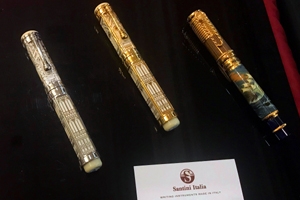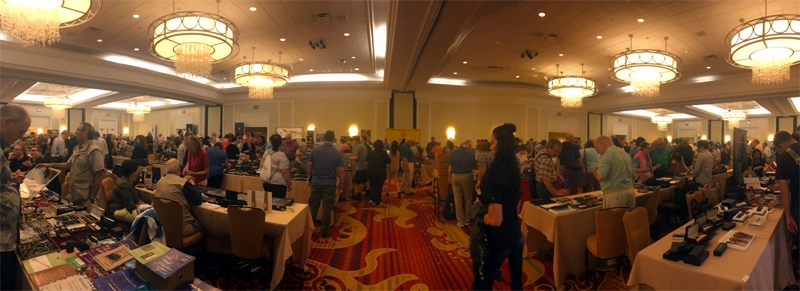
Just outside of Washington, D.C. an annual event takes place. Unlike most events in the nation’s capital, this one has nothing to do with government. In fact, one could attend all four days of this event and never hear anything about politics. This is “The Washington D.C. Collectible Fountain Pen Supershow.” Its web site says that it is the largest pen event in the world.
“What,” the casual reader might ask, “is a pen event?”
To put it simply, it is a marketplace and social gathering for those who collect and use fountain pens.
A Brief History
To many, the fountain pen would seem to be the writer’s equivalent of the passenger pigeon—once common but no longer seen. Coming onto the scene in the eighteen-eighties, credit for inventing the fountain pen is usually given to Lewis Waterman, who got a patent in 1884 and started his own company to produce them—that still exists today. Actually, Waterman’s patent covered an improvement in already existing pens. His innovation was a process that could control the flow of ink that comes from the nib of the pen.
For the first half of the twentieth century, getting a fountain pen was a sign of passage into adulthood. Often, it would be a gift received at graduation or some religious event like confirmation. They were not inexpensive. The Parker 51, a popular pen of the time, cost $12.50 and up, depending on finish (plastic, silver, gold, etc.) in 1949. That translates to approximately $130.00 today. These were not cheap throw- away pens. They were made to last, and they did—one is sitting in a pen holder, ready for use as this writer composes this story.
 If any readers have never used a fountain pen, there is much to recommend it. Unlike modern pens which work on friction, the ink flows from a fountain pen effortlessly as the hand guides it across the paper. The pen is held more lightly, so there is significantly less ‘writer’s cramp’ when using it. Fountain pen ink is available in a wide variety of colors. There is a reassuring heft in the pen. It inspires one to write beautifully. Handwriting is, or at least can be, an art form—an expression of the writer’s creativity in a way that typing on a keyboard never can be.
If any readers have never used a fountain pen, there is much to recommend it. Unlike modern pens which work on friction, the ink flows from a fountain pen effortlessly as the hand guides it across the paper. The pen is held more lightly, so there is significantly less ‘writer’s cramp’ when using it. Fountain pen ink is available in a wide variety of colors. There is a reassuring heft in the pen. It inspires one to write beautifully. Handwriting is, or at least can be, an art form—an expression of the writer’s creativity in a way that typing on a keyboard never can be.
What Does Saint Thomas Say About Immigration?
Of course, the fountain pen has its limitations. Ink can spill from the bottle if not careful. Pens go dry when ink bottles are not nearby. They can leak. They do not react well to the pressurized cabins of airplanes. Those of a certain age may remember little plastic devices called pocket protectors. They were invented to deal with a common fountain pen problem.
In response to these issues, the ballpoint pen was invented and dominated the market by 1960. Felt tip and rollerball pens later followed. All were more convenient and considerably less expensive. The fountain pen manufacturers tried to make things easier by putting the ink in a small transparent plastic cartridge that was loaded in the fountain pen, but it never really caught on. A few clung to their well-used and well-loved fountain pens, but most of them ended up in the back of a drawer, too expensive to throw away and too inconvenient to use.
 The Revival of a Tradition
The Revival of a Tradition
Exactly when the foibles of the fountain pen shifted from nuisance to nostalgia is unrecorded. The fountain pen never really left the luxury market and were still advertised through the sixties and seventies. (Queen Elizabeth is said to use a gold capped Parker 51).
However, at some point, things started happening in the fountain pen world. Grandchildren found the strange but yet familiar devices and asked what they were. Others started looking for the pens at estate sales. Old repair manuals were dusted off and old but never used parts found. Books were written. Gradually use of a fountain pen became a sign of individuality, of marching to the beat of a different drummer. Enthusiasts started trading amongst themselves. Clubs were formed.
What does Saint Thomas Aquinas say about Marriage?
Out of those clubs came pen shows like the one in Washington, where thousands of people will give up part of their weekend to look at, admire, buy, and sell their pens. Old manufacturers in both Europe and the United States resumed production, and seemingly dead crafts were revived.
Even in the heyday, some fountain pens had been works of art. They sat at the intersection of tool and jewelry, another way of displaying wealth. Gold, silver, titanium, and other precious metals were crafted into unique patterns for the pens of the wealthy. These became the items most highly sought by a new breed of pen collectors.
 Responding to these new conditions, new manufacturers came into the market. These were not the worldwide companies of the first half of the twentieth century, but small shops in which individuals craft quality pens. One can actually meet the manufacturers at the pen shows. Typical was Giovanni Santini, who makes his pens in Italy. He finds his inspiration in great artists, ancient buildings and other cultures.
Responding to these new conditions, new manufacturers came into the market. These were not the worldwide companies of the first half of the twentieth century, but small shops in which individuals craft quality pens. One can actually meet the manufacturers at the pen shows. Typical was Giovanni Santini, who makes his pens in Italy. He finds his inspiration in great artists, ancient buildings and other cultures.
 An Organic Society
An Organic Society
The beauty of the fountain pen revival is that it happened organically. That is to say that the demand for the product rose up naturally. Likewise, the producers responded and tailored their products to the consumers. The end results are pens that are the joint creation of producer and consumer. They are unique and delightful.
Such pens are a refreshing contrast to the mass market offerings that tend to impose the same product on a global population. One does not see in this production the artificial price supports, government bailouts, cutthroat competition and other practices that make up the frenetic intemperance of modern markets.
Rather, one sees in a pen event the remnants of what is called an organic society. In his book, Return to Order, author John Horvat defines an organic society as “a social order oriented toward the common good that naturally and spontaneously develops, allowing man to pursue the perfection of his essentially social nature.”
At the pen event, people came together who simply refuse to give up a part of life that brings them satisfaction and fulfillment. The visitors peruse this traditional craft for the sheer joy of admiring something beautiful and excellent. Shop owners and craftsmen see a demand and naturally and spontaneously develop the skills and products to fill that desire. At the core of it all is a celebration of excellence and beauty whereby the simple art of crafting pens makes handwriting a pleasure both to produce and to read. It is simple, it is organic, and it is beautiful.
[like url=https://www.facebook.com/ReturnToOrder.org]


